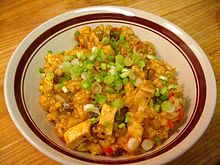Cajun cuisine
The Cajun cuisine ( ) is the cuisine of the descendants of French-born settlers in the US state of Louisiana , the Cajuns ([ ˈkeid.ʒəns̩ ] ( )). This is a rather simple and rustic cuisine made from locally available ingredients. Closely related to Cajun cuisine is Louisiana Creole cuisine , which corresponds to a somewhat more sophisticated style of cooking that developed in the cities with a focus on New Orleans .
Today, Louisiana cuisine traditions have been blended together, but originally Cajun cuisine was only available in Cajun Country , Creole cuisine in New Orleans, and traditional Southern cuisine in northern Louisiana .
Use of terms
Today, the term Cajun cuisine is often used vaguely for various cooking traditions in the state of Louisiana; in addition, it has become a fashion term since the 1980s, with which various products and specialties of the region are marketed. The author Marcelle Bienvenu points out that the Cajun cuisine we know today was largely created in the 20th century and is very different from the original cuisine of the Cajuns . Until then, there was a lot in common with the soul food of the colored population in the southern USA. Up until the 19th century, rice played a completely subordinate role, as rice cultivation only began on a larger scale in Louisiana after 1865.
Truly traditional dishes are jambalaya and gumbo . Crayfish only became a typical ingredient in Cajun cuisine after the Breaux Bridge Crawfish Festival in 1959, before they were only used as a fasting food.
General
Both Creole and Cajun cuisines were influenced by the French, Spanish, Italian, African, and German cuisines of other immigrants and adapted to the ingredients present in the Mississippi River Delta . The typical dish gumbo, for example, may have evolved from the French bouillabaisse , while the jambalaya is similar to the Spanish paella .
In the Cajun Country , pigs and poultry are traditionally kept, less cattle. Corn , okra , chilli , onions , garlic and various other vegetables are grown . Rice is cultivated in part of the region . Fishing also plays an important role.
In spring, crawfish are traditionally cooked and eaten outdoors together with vegetables ( crawfish boil ). This is considered a special delicacy and is a family celebration. Outside of Louisiana, Cajun cuisine has long had a reputation for being poor man's cuisine. That has changed since the 1980s; since then, numerous Cajun cookbooks have appeared, and there are Cajun restaurants all over the world. The Louisiana chef Paul Prudhomme popularized a modified and reinterpreted style of Cajun cuisine in the United States.
Basics

A Cajun meal is often prepared in three pots: One contains the main course, one contains the rice, the popular corn bread or other grain, and the third contains the vegetables. But one-pot dishes are also typical.
Spices such as parsley , thyme , garlic , bay leaves , shallots and filé powder (ground leaves of the sassafras tree ) play an important role in Cajun cuisine . Ready-made Cajun seasoning mixes are also available. The Cajun cooking is spicy to spicy, there are often invented in Louisiana Tabasco sauce or other chili sauce and cayenne pepper used.
Typical ingredients
Since the Cajun cuisine comes from the Mississippi Delta, which consists to a large extent of marshland and is close to the sea, there are crawfish , catfish , umberfish (redfish), shrimp , oysters , but also frog legs and Alligators are popular ingredients, as are all types of poultry and pork.
Sweet peppers , onions and celery are considered the "Holy Trinity" ( Holy Trinity ) represented by the Cajun and form diced and fat scorched the basis of typical dishes such as gumbo, jambalaya or Dirty Rice . In addition to the above, other popular vegetables include sweet potatoes , tomatoes, and all kinds of beans . Play an important role broths ( cane ) and gravy ( gravy ), and typical of the Cajun cooking is the strong searing various ingredients such as fish and poultry, which are then referred to as "Blackened".
Many dishes are based on roux , a roux , which in the Cajun kitchen is typically prepared with plenty of vegetable oil or lard, is usually stirred until it is nut brown and is used not only as a binding agent for sauces and soups such as gumbo, but primarily as a flavoring agent.
The pecans and brown sugar or sugar cane syrup, which are native to the southern United States, are often used for desserts .
Typical dishes
- Andouille , a spicy, heavily smoked pork sausage
- Bisque, a thick, creamy soup, often with seafood, such as lobster cream soup or crawfish bisque
- Boudin blanc, a spicy grützwurst , and Boudin rouge, which is enriched with pig's blood
- Calas, sweet rice cakes
- Crawfish étouffée, a ragout made from crayfish , served with rice
- Crawfish pie, a pie made from crayfish
- Dirty Rice
- Grillades, thin slices of sausage with tomato sauce
- gumbo
- Jambalaya
- Maque Choux, a hearty side dish made from corn
- Pecan pralines, which, unlike European pralines, are made from caramelized brown sugar and cream
- Southern Fried Catfish, fried catfish
- Tasso , a pork ham mainly used for seasoning
literature
- Marcelle Bienvenu among others: Stir the Pot. The History of Cajun Cuisine. Hippocrene Books, New York NY 2005, ISBN 0-7818-1120-1 .
- John D. Folse: The Encyclopedia of Cajun & Creole Cuisine. Chef John Folse & Co., Gonzales LA 2004, ISBN 0-9704457-1-7 .
Web links
- Exhibition catalog: What's cooking in New Orleans (pdf) (2.99 MB)
- Louisiana's Creole & Cajun Cuisine ( Memento from February 3, 2012 in the Internet Archive )
- Article Cajun Cooking in the Encyclopedia of Food and Culture
Individual evidence
- ↑ Marcelle Bienvenu et al. a., Stir the Pot: The History of Cajun Cuisine, 2005

